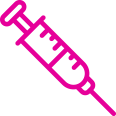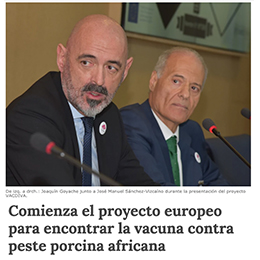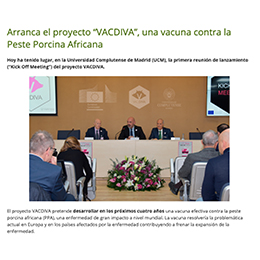
ASF2
CURRENT STATUS

AFRICAN SWINE FEVER
Disease profile
African swine fever (ASF) is a serious infectious disease of domestic and wild pigs of all breeds and ages. Its importance is due to the high lethality in domestic pig and wild boar, the great diffusion capacity and the lack of treatment and vaccine. The ASF virus is endemic in sub-Saharan Africa, where the virus infects wild and domestic suids as well as ticks of the genus Ornithodoros. Nevertheless, there have been several incursions of the disease out of Africa (Europe, South America and the Caribbean) between the 1960s and 1970s, which had a high cost of eradication. In 2007 the disease was introduced into Georgia, from where it spread to other eastern European countries. Currently, the disease affects 18 European countries, 10 of them belonging to the European Union. In 2018, the virus first reached the Asian continent, from where it has spread rapidly to 12 countries.
Risks
The current situation of African swine fever has acquired a pandemic dimension and suggests an imminent risk for world swine production. The disease has spread to 47 countries on three continents and the 77% of total swine population is already living in an infected area. China, the main pig producer, with about half the head of pigs from around the world, has lost more than 37% of its porcine population. Globalization has increased the risk of ASF being introduced into free areas. The main risks of ASF spread are the continuous movement of infected wild boar populations in Europe, the poor levels of biosecurity in farms and the movement of live pigs and risk products coming from infected areas.
What do we have?

DIAGNOSTICS
A number of good and fast diagnostic tools for different types of samples are available for both virus and antibody detection. Most of the existing tools allow early detection of the disease and a confident diagnosis in any epidemiological situation of affected countries. There are also good diagnostics tools for on-site first-line diagnosis.

VACCINES
Vaccination is considered to be the most efficient strategy and solution for emerging infectious diseases. Regrettably, attempts over many years to develop a vaccine for ASF have failed. Last year new several new vaccines prototypes for domestic pig and wild boar have been described with very promising results. A EU project, “VACDIVA”, has been financed with 10 million euros by the European Union with the objective of develop and effective vaccine against ASF over the next four years (VACDIVA H2020 Grant ID: 862874).

PHARMACEUTICALS
The use of antivirals has been proposed as a control alternative until a commercial vaccine is obtained. Several prototypes have been determined so far and their efficacy has been tested under in vitro conditions, however, in vivo studies have still been conducted.
What is needed?
Elucidation of the immune response to infection for the identification of target proteins and genes for vaccination.
Characterisation at genome level of ASFV infection with different isolates.
Characterisation of the different epidemiological scenarios worldwide for ASF and design ASF control and eradication strategies for each of them. Diagnostics: i) expansion of field validation for all tests and appropriate specimens; ii) established cell lines that make virus isolation a cost-effective test for its implementation at the National Reference Laboratories; iii) improvements in molecular characterization tests to determine the source of the outbreaks; and iv) develop DIVA test to allow and accurate monitoring of the effectiveness of the potential vaccine.
Major efforts to provide an effective and sufficiently effective and safe vaccine for wild boar and domestic pig.



